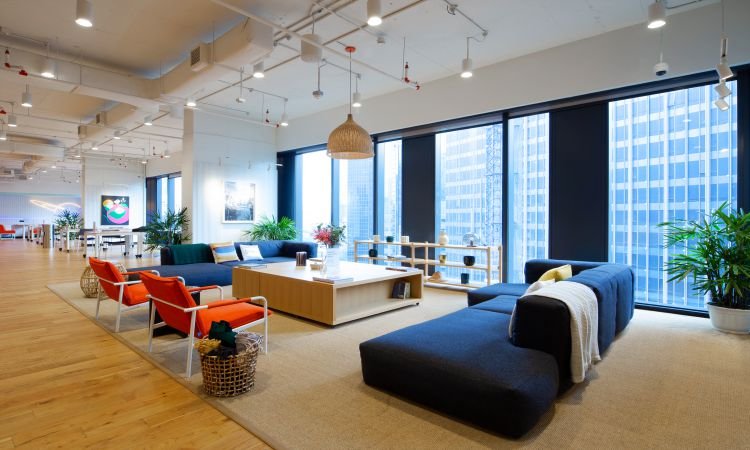 ‘Agile working’ may sound like a corporate term, but it’s a significant strategic business technique. Simply put, agile working provides your employees with the tools, technology, and space required to operate in a manner that best matches their specific objectives at any given time. However, how does workplace design fit into the mix?
‘Agile working’ may sound like a corporate term, but it’s a significant strategic business technique. Simply put, agile working provides your employees with the tools, technology, and space required to operate in a manner that best matches their specific objectives at any given time. However, how does workplace design fit into the mix?
Agile workplace design offers workers a range of productive spaces because being agile also gets things done. With an agile working space, employees may decide where and when to work best. An agile workplace also reduces physical boundaries between teams and increases employee satisfaction, improving cooperation and creative potential.
Some experts can help you design a functional and welcoming workplace for all employees and visitors. You may check out this best page and similar sites for reference.
So, how exactly does one go about designing an agile workplace?
1. Provide Spaces For Communication, Collaboration, And Private Work
Everyone isn’t a fan of working next to their coworkers. Noise and visual interruptions can affect the most crucial initiatives and regular work. While transparency can help foster teamwork, sometimes individuals or small groups of employees need to get away from the crowds and work alone.
Prioritizing the construction of private and safe workspaces for employees is essential for an agile office to succeed. Because of the increased interaction and distractions of working in an open space, many people find difficulty adjusting to the new environment. As a result, an introvert who might otherwise make an excellent team member can opt out of the office.
To accommodate a wide range of personalities, agile offices must provide a variety of meeting spaces, such as office booths or conference rooms.
2. Ask Your Employees For Their Opinions
 Facility managers should interview workers about furniture, layout, and technologies. Doing so will let you know your adjustments will be for the betterment of the workplace and boost employee productivity.
Facility managers should interview workers about furniture, layout, and technologies. Doing so will let you know your adjustments will be for the betterment of the workplace and boost employee productivity.
Moreover, collect employee feedback when implementing workplace adjustments. They’ll be using the area, so they are likely to offer suggestions you haven’t considered and other design aspects, such as ‘break-out spaces.’ Here, employees may get away from their computers, hold chill meetings, and dine and chat with colleagues from other teams. Flexible spaces with soft, comfy furniture also offer a home away home feeling. Couches, armchairs, coffee tables, lamps, ping-pong tables, and entertainment machines can also help employees relax.
3. Invest In Plug & Play Tech
Agile workplaces encourage employees to move throughout the office during their working hours. However, if it takes several minutes to get their laptops set up or connect to audio or videoconference equipment every time they move, they are more likely to stay put.
Docking stations are essential in offices because they allow workers to move from one area to another without disruption. Additionally, employees who require a more reliable connection than Wi-Fi should have access to fixed-line internet connections. Workstations with one screen or many displays should be available for employees, depending on their day-to-day tasks.
Each of these technologies should be simple to use, allowing workers to plug in their laptops and begin to work immediately.
What Defines An Agile Workplace?
Agility is more than a set of concepts and practices; everyone must adopt an agile approach to realize its benefits. In a nutshell, here are the characteristics of an agile work environment:
-
Access
Flow is a function of both agility and access. Employees must enter and exit spaces with ease. Doors, walls, and other objects may restrict the ability to adapt. In dynamic work environments, people don’t like to be constrained.
-
Comfort
You must be comfortable to get the job done. Employees will spend more time adapting than working if they cannot focus on their tasks because of their new surroundings.
-
Peace
Maintaining a sense of privacy and tranquility in open areas can be challenging. Workers can better focus on their work when there is less noise and distraction in the office.
-
Adaptability
Has anyone shown the ability to change plans when circumstances demand it? Do you have an area big enough to accommodate a standing desk? You’ll be able to meet the needs of everyone in the workplace if you know what they’re looking for in an office.
You can reinforce these essentials by paying attention to design. Lighting and plants can help create a sense of calmness, too. Besides, adaptability and accessibility are supported by smart technology. Therefore, you must pay attention to the small things when working in a fast-paced environment.
Takeaway
Switching to an agile working environment isn’t an easy feat. It may be exhilarating, but it also poses difficulties because you require individuals to change habits, patterns, and procedures they’ve used for years.
Furthermore, agile workspaces can be anything you choose. You can customize it to your goals, requirements, business needs, and employees’ requests.
To start, define what it means to be agile for you and your organization. Indeed, a collaborative relationship is the first step toward creating a flexible, agile work environment that adapts to shifting priorities.




